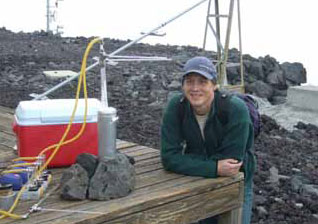
Fingerprints in water
Atmospheric sciences professor David Noone “chills” by the cryogenic trap, which collects water vapor molecules by freezing them.
atom, with slightly different weights and slightly different behaviors. Water molecules with heavy isotopes preferentially condense, for example.
How do isotopes help science?
Because condensation and evaporation occur in different locations, and those processes favor different isotopes of water, scientists can use isotopes to “fingerprint” air masses, revealing where moisture is added and removed from the atmosphere. Isotopes of hydrogen and oxygen can help put constraints on the water budget, Noone said, and can also reveal cloud processes and the histories of air masses as they travel the globe.
What’s next?
Ultimately, Noone plans to develop a long-term monitoring network and use isotopes to learn about how changing humidity conditions–and the processes that drive them–will affect Earth’s climate.![]()
Water might get little public attention for its role in climate change, but water vapor is just as important a greenhouse gas as carbon dioxide. In 2008, CIRES’ David Noone and colleagues set up the first real-time experiments to measure water vapor on Hawaii’s Mauna Loa Mountain.
There, at the high-altitude Mauna Loa Observatory, researchers can make measurements of a part of the atmosphere where the relative humidity is very low. Understanding the water cycle in this low-humidity environment is important for evaluating watervapor’s role in amplifying Earth’s greenhouse effect.
Noone spent October on the mountain, using a trio of new optical sensors to measure isotopic differences of hydrogen and oxygen atoms in the water molecules of Hawaii’s air.
What are isotopes?
Isotopes are different versions of the same


